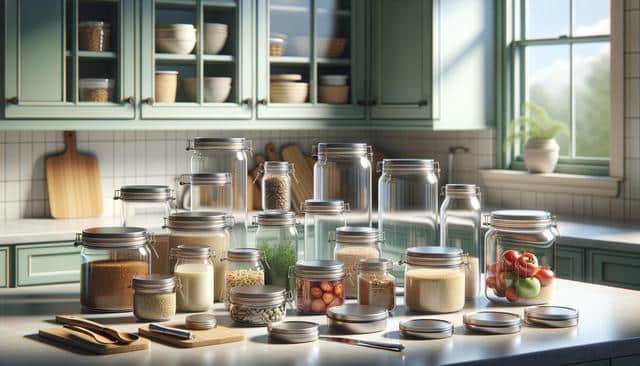
Smart Food Storage: Organize, Preserve, and Reduce Waste
Understanding Different Types of Food Storage Containers
Food storage containers come in a wide range of materials, shapes, and sizes, each designed for specific uses. Knowing the differences can help you choose the most suitable option for your kitchen. Common materials include plastic, glass, stainless steel, and silicone. Plastic containers are lightweight and often more affordable, while glass offers a non-reactive surface ideal for acidic foods. Stainless steel is durable and resistant to odors, and silicone is flexible and collapsible, making it great for saving space. Each material has its strengths and potential drawbacks, so consider what features matter most to you, such as microwave safety, freezer compatibility, or dishwasher friendliness.
In addition to materials, container shapes and lid mechanisms vary. For example:
- Round containers are ideal for liquids like soups and stews.
- Square and rectangular shapes maximize storage space in refrigerators and cabinets.
- Clip-lock lids or twist tops provide extra security against leaks.
Choosing the right type of container for your storage needs helps you keep your food fresher for longer and simplifies your kitchen organization.
The Importance of Airtight and Leak-Proof Sealing
One of the key features to look for in food storage containers is an airtight seal. Containers with airtight lids prevent air from entering, which significantly slows down the spoilage process and helps retain moisture and flavor. This is particularly important for perishable items such as fruits, vegetables, or cooked meals.
Leak-proof containers are another essential, especially for people who transport food regularly, such as commuters or schoolchildren. A reliable seal prevents spills in bags and lunchboxes, keeping both your food and belongings safe. When assessing container lids, look for those with silicone gaskets or locking mechanisms, as these often provide a more secure seal than simple snap-on lids.
Good sealing also plays a major role in preventing cross-contamination and reducing odors in the fridge. This is beneficial for households storing a variety of food types, from raw meats to pungent leftovers.
Organizing Your Kitchen with Stackable and Space-Saving Designs
Efficient kitchen organization becomes easier with stackable food storage containers. These designs not only save space in your refrigerator or pantry but also make it easier to find what you’re looking for. Modular containers, which nest inside one another when not in use, are especially useful for small kitchens or minimal storage areas.
Clear or transparent containers also help visually track what’s inside, reducing the likelihood of forgotten leftovers that go to waste. Labels or color-coded lids can further improve organization by allowing you to quickly distinguish between food types or meal prep categories.
To enhance your kitchen organization, consider the following tips:
- Use shallow containers for quick-access items like snacks or chopped veggies.
- Dedicate a section of your pantry or fridge to meal prep containers.
- Group similar-sized containers together for easier stacking and storing.
By incorporating space-saving and stackable containers, you create a cleaner and more efficient cooking and storage environment.
BPA-Free and Food-Safe Materials Matter
Health-conscious consumers often prioritize food safety when selecting storage containers. BPA (bisphenol A) is a chemical used in the production of some plastics and has been linked to potential health concerns. While many manufacturers have phased out BPA in food containers, it’s still important to verify that your containers are clearly marked as BPA-free.
Choosing containers made from food-grade materials ensures they won’t leach harmful substances into your food, particularly when exposed to heat, such as in microwaves or dishwashers. Glass, stainless steel, and newer silicone options are generally considered safe choices. If using plastic, look for those labeled with recycling codes #1, #2, #4, or #5, which denote safer plastics for food storage.
Key benefits of using BPA-free and food-safe containers include:
- Reduced risk of chemical exposure.
- Improved food taste and quality.
- Peace of mind when reheating or freezing food.
Being mindful of the materials used in your containers is not only better for personal health but also supports more responsible manufacturing and sustainability practices.
Food Storage for Meal Prepping and Long-Term Preservation
Food storage containers play a vital role in meal prepping and long-term food preservation. For meal preppers, having a variety of container sizes allows for portion control and organized weekly planning. Containers with compartments can separate different components of a meal, making them ideal for balanced lunches or dinners on the go.
For long-term storage, especially in freezers or pantries, durability and sealing capabilities become even more important. Freezer-safe containers should resist cracking at low temperatures and protect against freezer burn. Look for containers labeled as freezer-safe and ensure they leave a bit of headspace to allow for food expansion.
When used effectively, food storage containers can help reduce food waste and save money by preserving leftovers and bulk purchases. Consider these practices for optimal long-term storage:
- Label and date each container before freezing or refrigerating.
- Use vacuum-sealed containers for dry goods like grains, nuts, and pasta.
- Rotate older items to the front to ensure they’re used first.
Whether you’re preparing meals in advance or storing seasonal produce, the right food storage containers make the process efficient and safe.
Conclusion: Choosing the Right Containers for Your Lifestyle
Food storage containers are more than just kitchen accessories—they’re essential tools for reducing waste, organizing your kitchen, and maintaining healthy eating habits. By understanding material options, prioritizing airtight and BPA-free designs, and using space-saving strategies, you can create a more efficient and sustainable food storage system. Whether you’re a meal prep enthusiast, a busy parent, or simply someone looking to improve kitchen organization, investing in quality food storage solutions tailored to your lifestyle offers long-term benefits that go beyond convenience.


